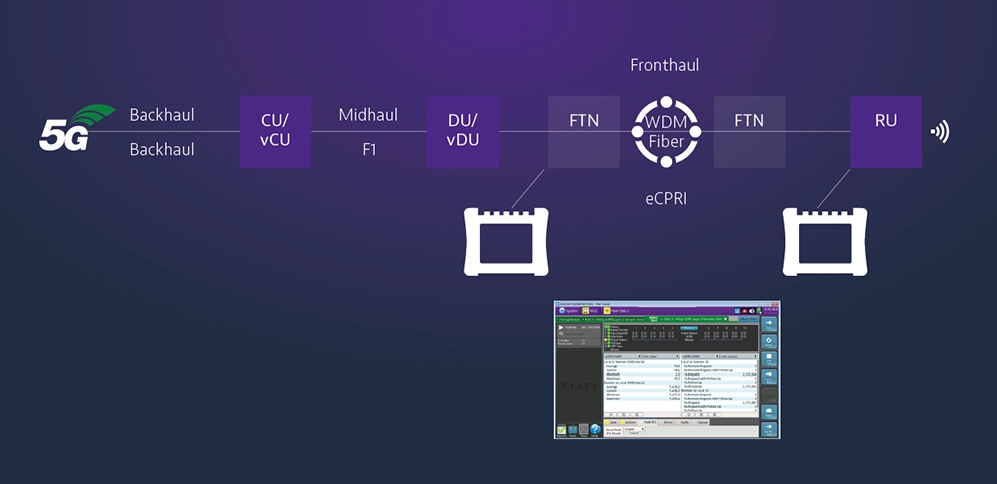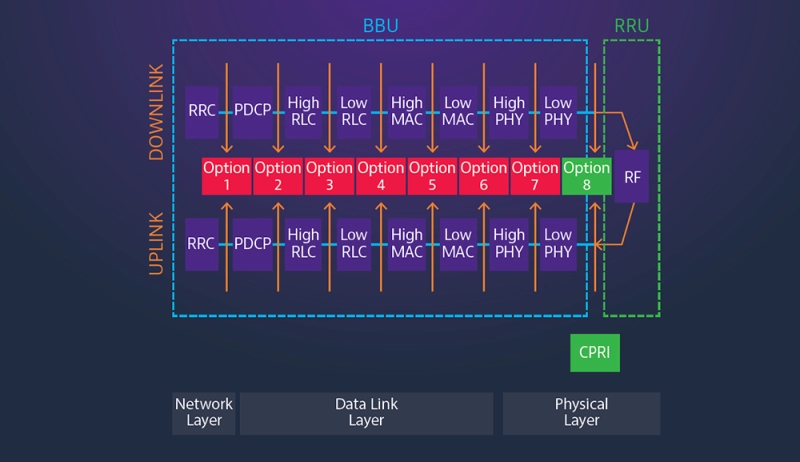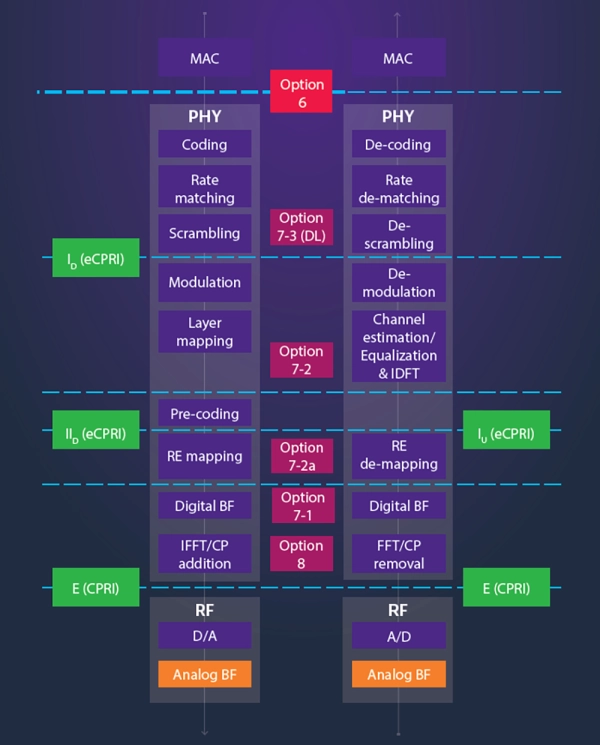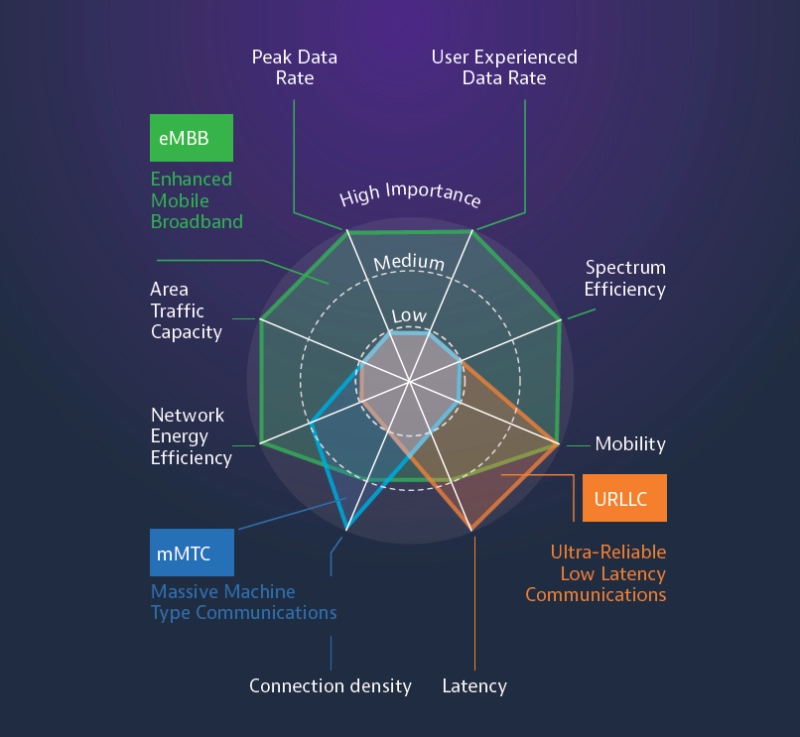Fronthaul
Learn about fronthaul and its important role in the advancement of 5G
What Is Fronthaul?
Fronthaul is defined as the fiber-based connection in RAN infrastructure between the Baseband Unit (BBU) and Remote Radio Head (RRH). Fronthaul originated with LTE networks when operators first moved their radios closer to the antennas. This new link was established to supplement to the backhaul connection between the BBU and central network core.
As new 5G use cases roll out, flexible fronthaul configurations have become an essential ingredient for balancing the latency, throughput and reliability demands of advanced 5G applications.
Next-generation RAN is resulting in increased fronthaul fiber deployment and a greater reliance on multiplexing, virtualization and split fronthaul architecture. This has placed eCPRI fronthaul among the most important 5G technologies in operator surveys. VIAVI provides a comprehensive solution for fronthaul performance testing including fiber link verification, synchronization, and timing test capabilities, as well as virtual and assurance-based options.
Evolution of Fronthaul
The evolution of fronthaul in mobile networks has mirrored the increasing reliance on optical fiber for broadband networks, as bandwidth and latency requirements in both domains have continued to drive fiber deployments deeper and higher. Prior to the release of 4G, fiber was used primarily for transport networks. Higher performance standards, the development of multiple input, multiple output (MIMO) technology and advanced radio coordination practices dovetailed with the arrival of remote radio solutions and the introduction of fronthaul to the optical fiber lexicon.
The Common Public Radio Interface (CPRI) protocol was first established in 2003 by a consortium of OEM's to define and standardize the transport, connectivity and control specifications between the BBU and RRH. CPRI was based on co-located Physical Layer (PHY), Data Link Layer and Network Layer architecture in the BBU with fronthaul providing the link between the RRH and the PHY layer of the BBU. The stringent delay budget of CPRI limited the physical separation between BBU and RRH positions.
CPRI uses a synchronistic data transfer protocol with bitrates dependent on antenna quantity thus creating transfer rates that do not adjust for variation in user load. This is analogous to a train leaving the station devoid of passengers on one trip, then returning to find an overflow of travelers waiting for the next.
The tagging burden of CPRI is high and statistical multiplexing is limited. These inherent CPRI inefficiencies have been workable for 4G/LTE fronthaul, but are highly impractical, as well as expensive, to scale for massive MIMO, high bandwidth, and low latency 5G transport. The innovative solution, as defined by 3GPP TR 38.801, IEEE and ITU-T calls for the functional split of BBU elements.
The components of this new architectural model are defined as the RU (previously known as RRH and RRU), Central Unit (CU) and Distributed Unit (DU), with the new link between the CU and DU appropriately referred to as midhaul. RAN virtualization has enabled BBU functions to be located or collocated within the various elements, depending on which functional split between OSI layers best suits the use case requirements. The flexibility of split architecture is essential for optimizing key use cases on 5G fronthaul networks simultaneously.
Fronthaul vs Backhaul
Split RAN architecture has reshaped the traditional definitions of fronthaul and backhaul. In its earliest incarnation, backhaul was simply described as the connection between the wireless network and wired network through either cable or optical fiber. Fronthaul became a necessary addition when the ante for bandwidth and efficiency was raised with LTE and a new link connected centralized baseband units to individual radio heads.
When you bring together fronthaul and backhaul architecture (as well as midhaul), it is also known as crosshaul (or x-haul or xhaul).
Network function virtualization (NFV) has created new opportunities for modularity and customization that break down the existing paradigm even further. DU and/or CU functions can be integrated with the RU, the DU may be combined with the CU or each element can function independently at separate locations. In each instance, the backhaul still provides the connecting link to the core.
O-RAN Fronthaul
Traditionally, large equipment vendors have implemented CPRI in a proprietary fashion which has limited operators to a single-vendor approach to fronthaul network architecture. Breaking down this siloed ideology is the fundamental concept behind Open RAN (O-RAN). The O-RAN ALLIANCE is committed to a structured migration towards multi-vendor, autonomous RAN elements.
For O-RAN fronthaul, open, virtualized architecture using generic hardware and software will facilitate interoperability among combinations including open distributed units (O-DU) and open radio units (O-RU) from different vendors. This standardization will level the competitive playing field and spur innovation while allowing operators to transparently and cost effectively mix and match fronthaul elements.
Fronthaul Networks
Achieving gigabit speeds and 1-millisecond latency raises the bar for all aspects of 5G infrastructure including the established boundaries of fronthaul transport capacity. Fiber is transmission media that can overcome these obstacles with scalable fiber management and flexibility needed to meet the ever increasing fronthaul demands. Dark fiber, if available, is the most cost-effective option for an immediate fronthaul network capacity boost. This solution also offers one of the best options, with fast deployment and the lowest impact on latency.
WDM
Wave division multiplexing (WDM) can enable more efficient use of fronthaul fiber links. By transmitting over multiple wavelengths, traffic from several antennas can be sent through the network over a single dark fiber. Coarse WDM (CWDM) enables operators to transmit up to 18 channels simultaneously. The passive nature of CWDM reduces cost and complexity. Dense WDM (DWDM), designed to take advantage of erbium doped fiber amplifiers, can create up to 96 independent channels. DWDM can be deployed either actively or passively depending on the distance required. Hybrid WDM options can also increase throughput by transmitting multiple DWDM frequencies over select CWDM channels.
Passive optical networks (PON)
Passive optical networks (PON) utilize optical splitters to create a point to multi-point topology. Passive fiber splitting in support of statistical multiplexing is a potential counterbalance for the density of RU connections inherent to massive MIMO technology.
Each additional split introduced within a 5G fronthaul network can double the existing capacity, but also introduces a minimum 3dB loss even under ideal connection conditions. New innovations like WDM-PON combine enabling technologies by overlaying new wavelengths onto legacy PON networks without compromising the bandwidth of existing fixed access services. Additionally, NG-PON2 is emerging and utilizes WDM with multiple 10G wavelengths, both up and downstream, to deliver a symmetrical 40 Gbps service. NG-PON2 uses different wavelengths to G-PON and XG/XGS-PON to allow for service co-existence of all three on the same PON network.
5G Fronthaul
High-level use cases for 5G include Enhanced Mobile Broadband (eMBB), Massive Machine Type Communication (mMTC) and Ultra-Reliable Low Latency Communications (uRLLC). Each use case presents distinct challenges for 5G fronthaul performance. uRLLC applications such as autonomous vehicles with 99.9999% availability requirements must be maintained coincident with highly distributed or data intensive 5G applications such as the IoT or ultra- high density streaming.
The split fronthaul architecture considered optimal for one use case may be restrictive or even prohibitive for others making flexibility of paramount concern. By desegregating the network, incorporating a high level of virtualization and implementing packet-based synchronization, these three very different 5G use cases can be effectively supported on the same network at the same time.
5G Fronthaul Architecture
The evolution of 5G fronthaul architecture has created eight discrete functional deployment options each with inherent benefits and drawbacks with respect to latency, capacity and complexity. Each option is defined by the division points chosen between Physical, Data and Network layers with respect to RU, DU and CU configuration and location. Option 8 is equivalent to the current CPRI configuration with the high-level split occurring between the low Physical layer of the BBU and the RRH.
Fixed wireless applications delivering high bandwidth services to users in fixed locations are conducive to option 2, which places real-time functions within the radio head and creates an RU/DU functional element. Since high level coordination of multiple radio elements is not necessary, placing more functionality at the RU location can reduce the bandwidth and latency burden placed on the fronthaul, thereby allowing the CU to be positioned dozens of kilometers from the radio head.
Conversely, for the eMBB use case, options 6 and 7 pair only physical layer radio functions with the RU with the additional layers remaining in the CU/DU. This is more conducive to the coordination of multiple radios in mobile applications and reduces the fronthaul bitrate support. These options also introduce more stringent latency requirements that limit the geographic separation between RU and DU.
eCPRI Fronthaul
To standardize the split architecture of 5G fronthaul components, the CPRI consortium released the initial Enhanced Common Public Radio Interface (eCPRI) protocol in 2017. The stated purpose for eCPRI fronthaul adoption is to decrease data rate demands between radio equipment (eRE) and radio equipment control (eREC) while limiting complexity. Synchronistic CPRI data transfer is replaced by more efficient, packet-based protocols employing Ethernet or IP.
The future proof eCPRI fronthaul interface optimizes radio performance by using coordination algorithms to analyze and prioritize traffic in real time. The eCPRI protocol identifies three planes that are necessary for interaction between eRE and eREC. These planes include the user plane, the synchronization plane, and the control and management plane. The user plane transport definitions standardize data frame, packet, and header formats while the synchronization and control and management planes are not explicitly limited by eCPRI protocols.
Fronthaul Transport Network Nodes (FTN)
When CPRI and eCPRI are deployed simultaneously in a converged fronthaul configuration, a fronthaul transport network node (FTN) can be used to manage the Ethernet access ring. This scenario requires an effective test solution to ensure delay and synchronization requirements are within specifications.
The VIAVI T-BERD/MTS-5800-100G can be used to validate FTN performance in the lab, perform eCPRI tests, and accurately measure throughput, delay, and jitter. These flexible handheld network testers can also effectively perform GPS signal stability testing, PTP timing error testing, and Ethernet activation via the RFC 2544 and Y.1564 test methodologies.
Fronthaul Testing
5G fronthaul networks are heavily reliant on fiber connectivity for optimal performance. Next generation fronthaul architecture also necessitates complex real time spectrum analysis, timing and synchronization test capabilities. The VIAVI Timing Extension Module (TEM) can supplement the handheld T-BERD/MTS-5800 series network testers by providing nanosecond-precise 5G fronthaul timing and synchronization test capability in a rugged, field portable package. The TEM can also perform precise PTP timing error and PDV measurements.
The breadth of fronthaul deployment options makes an all-in-one base station analyzer with fiber testing, 5G service activation, Ethernet line rate, and OTN test capabilities invaluable in the lab as well as the field. The portable CellAdvisor 5G test instrument provides a complete solution for 5G fronthaul verification, cell site installation and commissioning, massive MIMO and antenna beam validation, along with integrated fiber inspection and validation functions.
Reliance on fiber division and multiplexing through PON and WDM technologies also increases the complexity of fronthaul fiber testing requirements, making traditional visual fault locator (VFL) and power monitoring practices insufficient in some instances.
The VIAVI suite of fiber optic tools extends from handheld fiber inspection and cleaning tools to powerful FiberComplete solutions to detect adverse events in complex fiber runs and perform bi-directional insertion loss (IL), optical return loss (ORL), and OTDR testing.
As fronthaul networks continue to leverage PON technology to meet the growing capacity demands, fronthaul testing practices will benefit from dedicated PON solutions for building, activating and maintaining 5G fronthaul installations. This includes wavelength selective PON power meters for flexibly adjusting to the deployed PON technology standards, centralized PON testing to validate and map PON networks, and PON-specific OTDR test solutions.
Featured Download
5G Fronthaul Transport Test Use Case

Request Immediate Access to the Fronthaul Handbook and Dive into Use Cases
Learn more about Fronthaul from VIAVI today!
Are you ready to take the next step with one of our fronthaul products or solutions?
Complete one of the following forms to get going:
Let Us Help
We’re here to help you get ahead.








